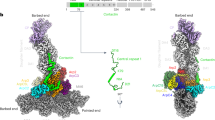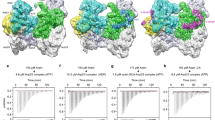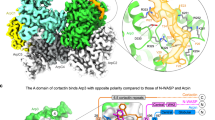Abstract
The two actin-related subunits of the Arp2/3 complex, Arp2 and Arp3, are proposed to form a pseudo actin dimer that nucleates actin polymerization. However, in the crystal structure of the inactive complex, they are too far apart to form such a nucleus. Here, we show using EM that yeast and bovine Arp2/3 complexes exist in a distribution among open, intermediate and closed conformations. The crystal structure docks well into the open conformation. The activator WASp binds at the cleft between Arp2 and Arp3, and all WASp-bound complexes are closed. The inhibitor coronin binds near the p35 subunit, and all coronin-bound complexes are open. Activating and loss-of-function mutations in the p35 subunit skew conformational distribution in opposite directions, closed and open, respectively. We conclude that WASp stabilizes p35-dependent closure of the complex, holding Arp2 and Arp3 closer together to nucleate an actin filament.
This is a preview of subscription content, access via your institution
Access options
Subscribe to this journal
Receive 12 print issues and online access
$189.00 per year
only $15.75 per issue
Buy this article
- Purchase on Springer Link
- Instant access to full article PDF
Prices may be subject to local taxes which are calculated during checkout





Similar content being viewed by others
References
Welch, M.D. & Mullins, R.D. Cellular control of actin nucleation. Annu. Rev. Cell Dev. Biol. 18, 247–288 (2002).
Robinson, R.C. et al. Crystal structure of Arp2/3 complex. Science 294, 1679–1684 (2001).
Zalevsky, J., Lempert, L., Kranitz, H. & Mullins, R.D. Different WASP family proteins stimulate different Arp2/3 complex-dependent actin-nucleating activities. Curr. Biol. 11, 1903–1913 (2001).
Weaver, A.M. et al. Interaction of cortactin and N-WASp with Arp2/3 complex. Curr. Biol. 12, 1270–1278 (2002).
Volkmann, N. et al. Structure of Arp2/3 complex in its activated state and in actin filament branch junctions. Science 293, 2456–2459 (2001).
Rodal, A.A., Manning, A.L., Goode, B.L. & Drubin, D.G. Negative regulation of yeast WASp by two SH3 domain-containing proteins. Curr. Biol. 13, 1000–1008 (2003).
Humphries, C.L. et al. Direct regulation of Arp2/3 complex activity and function by the actin binding protein coronin. J. Cell Biol. 159, 993–1004 (2002).
Mullins, R.D., Stafford, W.F. & Pollard, T.D. Structure, subunit topology, and actin-binding activity of the Arp2/3 complex from Acanthamoeba . J. Cell Biol. 136, 331–343 (1997).
Machesky, L.M. et al. Scar, a WASp-related protein, activates nucleation of actin filaments by the Arp2/3 complex. Proc. Natl. Acad. Sci. USA 96, 3739–3744 (1999).
Bailly, M. et al. The F-actin side binding activity of the Arp2/3 complex is essential for actin nucleation and lamellipod extension. Curr. Biol. 11, 620–625 (2001).
Gournier, H., Goley, E.D., Niederstrasser, H., Trinh, T. & Welch, M.D. Reconstitution of human Arp2/3 complex reveals critical roles of individual subunits in complex structure and activity. Mol. Cell 8, 1041–1052 (2001).
Pantaloni, D., Boujemaa, R., Didry, D., Gounon, P. & Carlier, M.F. The Arp2/3 complex branches filament barbed ends: functional antagonism with capping protein. Nat. Cell Biol. 2, 385–391 (2000).
Suetsugu, S., Miki, H., Yamaguchi, H., Obinata, T., & Takenawa, T. Enhancement of branching efficiency by the actin filament-binding activity of N-WASP/WAVE2. J. Cell Sci. 114, 4533–4542 (2001).
Egile, C. et al. Activation of the CDC42 effector N-WASP by the Shigella flexneri IcsA protein promotes actin nucleation by Arp2/3 complex and bacterial actin-based motility. J. Cell Biol. 146, 1319–1332 (1999).
Dayel, M.J., Holleran, E.A. & Mullins, R.D. Arp2/3 complex requires hydrolyzable ATP for nucleation of new actin filaments. Proc. Natl. Acad. Sci. USA 98, 14871–14876 (2001).
Le Clainche, C., Didry, D., Carlier, M.F. & Pantaloni, D. Activation of Arp2/3 complex by Wiskott-Aldrich syndrome protein is linked to enhanced binding of ATP to Arp2. J. Biol. Chem. 276, 46689–46692 (2001).
Le Clainche, C., Pantaloni, D. & Carlier, M.F. ATP hydrolysis on actin-related protein 2/3 complex causes debranching of dendritic actin arrays. Proc. Natl. Acad. Sci. USA 100, 6337–6342 (2003).
Dayel, M.J. & Mullins, R.D. Activation of Arp2/3 complex: addition of the first subunit of the new filament by a WASP protein triggers rapid ATP hydrolysis on Arp2. PLoS Biol. 2, E91 (2004).
Gietz, R.D. & Sugino, A. New yeast–Escherichia coli shuttle vectors constructed with in vitro mutagenized yeast genes lacking six–base pair restriction sites. Gene 74, 527–534 (1988).
Higgs, H.N. & Pollard, T.D. Activation by Cdc42 and PIP(2) of Wiskott-Aldrich syndrome protein (WASp) stimulates actin nucleation by Arp2/3 complex. J. Cell Biol. 150, 1311–1320 (2000).
Winter, D., Lechler, T. & Li, R. Activation of the yeast Arp2/3 complex by Bee1p, a WASP-family protein. Curr. Biol. 9, 501–504 (1999).
Van Heel, M., Harauz, G., Orlova, E.V., Schmidt, R. & Schatz, M. A new generation of the IMAGIC image processing system. J. Struct. Biol. 116, 17–24 (1996).
Harauz, G. & van Heel, M. Exact filters for general geometry three-dimensional reconstruction. Optik 73, 146–156 (1986).
Frank, J. & Radermacher, M. Three-dimensional reconstruction of single particles negatively stained or in vitreous ice. Ultramicroscopy 46, 241–262 (1992).
Frank, J. et al. SPIDER and WEB: processing and visualization of images in 3D electron microscopy and related fields. J. Struct. Biol. 116, 190–199 (1996).
Grigorieff, N. Three-dimensional structure of bovine NADH:ubiquinone oxidoreductase (complex I) at 22 Å in ice. J. Mol. Biol. 277, 1033–1046 (1998).
Huang, C.C., Couch, G.S., Pettersen, E.F. & Ferrin, T.E. Chimera: an extensible molecular modeling application constructed using standard components. Pac. Symp. Biocomput. 1, 724 (1996).
Wriggers, W., Milligan, R. & McCammon, J. Situs: a package for docking crystal structures into low-resolution maps from electron microscopy. J. Struct. Biol. 125, 185–195 (1999).
Acknowledgements
We are grateful to D. Sousa and M. Rigney for helping with image processing, and to H. Higgs for suggesting the bovine Arp2/3 complex experiments and generously providing those purified proteins. We thank H. Balcer, F. Chang, D. DeRosier, M. Eck and D. Pellman for scientific discussions and comments on the manuscript. H.R. was supported by the Swiss National Science Foundation. N.G. and B.G. were supported by the US National Institutes of Health. B.G. was also supported by a Pew Scholars Award and the American Cancer Society.
Author information
Authors and Affiliations
Corresponding author
Ethics declarations
Competing interests
The authors declare no competing financial interests.
Supplementary information
Supplementary Fig. 1
Difference maps between WASp-bound and open, intermediate, and closed structures. (PDF 182 kb)
Supplementary Fig. 2
Location of mutations in Arc35-5 and Arc35-6. (PDF 812 kb)
Supplementary Fig. 3
Response of Arc35-6 to WASp activation. (PDF 406 kb)
Supplementary Fig. 4
Arp2/3 preparations contain no contaminating WASp. (PDF 191 kb)
Supplementary Fig. 5
Electron micrograph of a field of Arp2/3 complexes. (PDF 1021 kb)
Rights and permissions
About this article
Cite this article
Rodal, A., Sokolova, O., Robins, D. et al. Conformational changes in the Arp2/3 complex leading to actin nucleation. Nat Struct Mol Biol 12, 26–31 (2005). https://doi.org/10.1038/nsmb870
Received:
Accepted:
Published:
Issue Date:
DOI: https://doi.org/10.1038/nsmb870
This article is cited by
-
Biochemical and mechanical regulation of actin dynamics
Nature Reviews Molecular Cell Biology (2022)
-
Nance-Horan Syndrome-like 1 protein negatively regulates Scar/WAVE-Arp2/3 activity and inhibits lamellipodia stability and cell migration
Nature Communications (2021)
-
Cryo-EM reveals the transition of Arp2/3 complex from inactive to nucleation-competent state
Nature Structural & Molecular Biology (2020)
-
WasC, a WASP family protein, is involved in cell adhesion and migration through regulation of F-actin polymerization in Dictyostelium
Journal of Microbiology (2020)
-
Abp1 promotes Arp2/3 complex-dependent actin nucleation and stabilizes branch junctions by antagonizing GMF
Nature Communications (2018)



